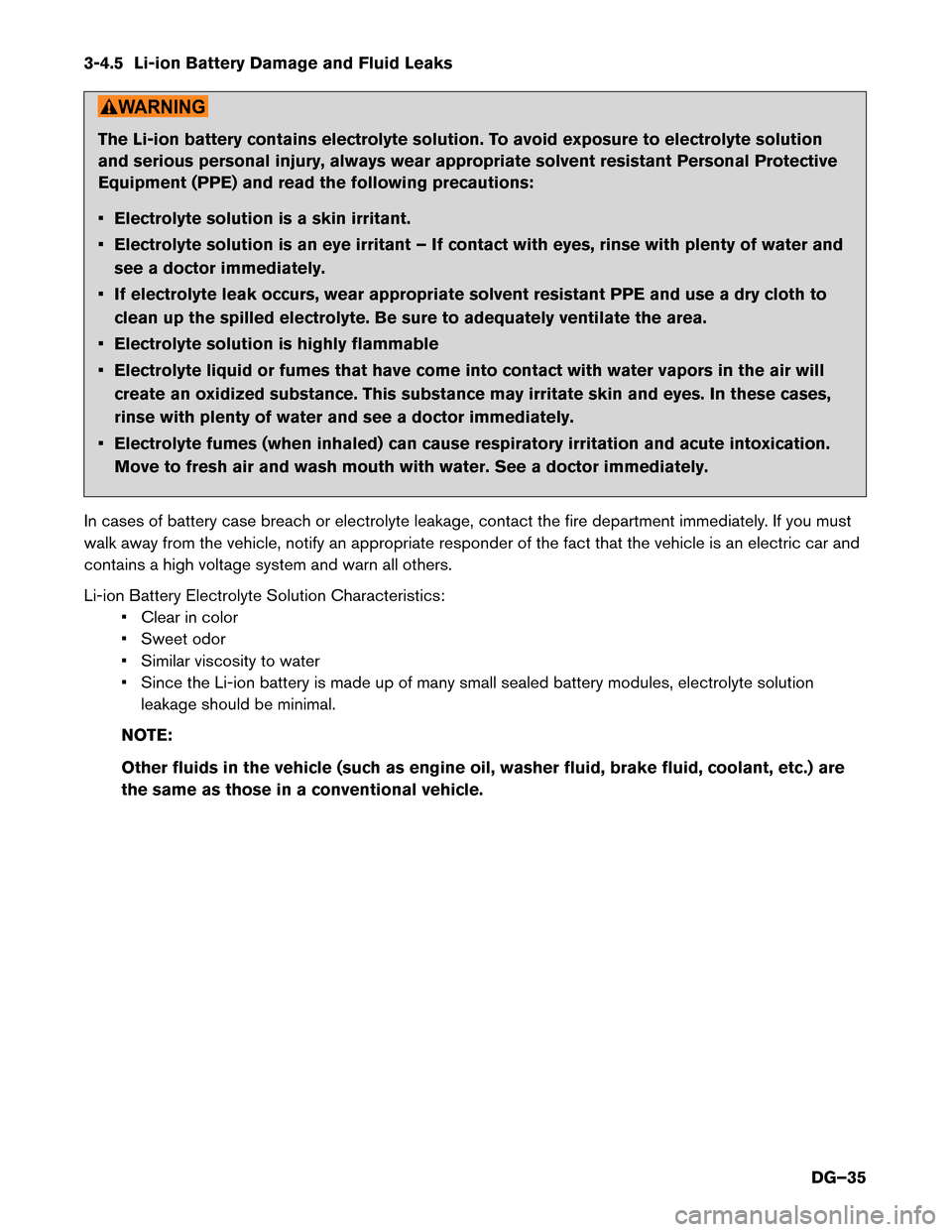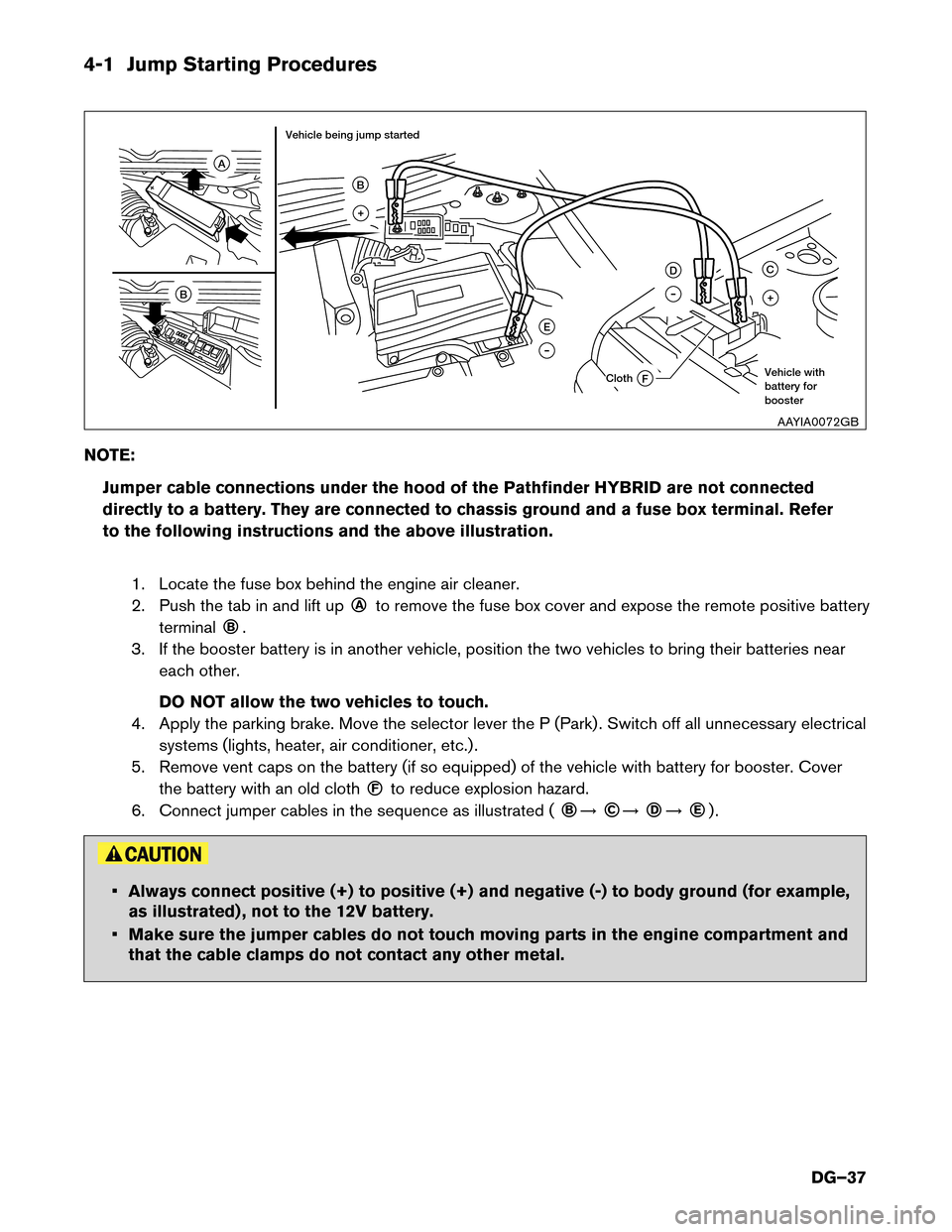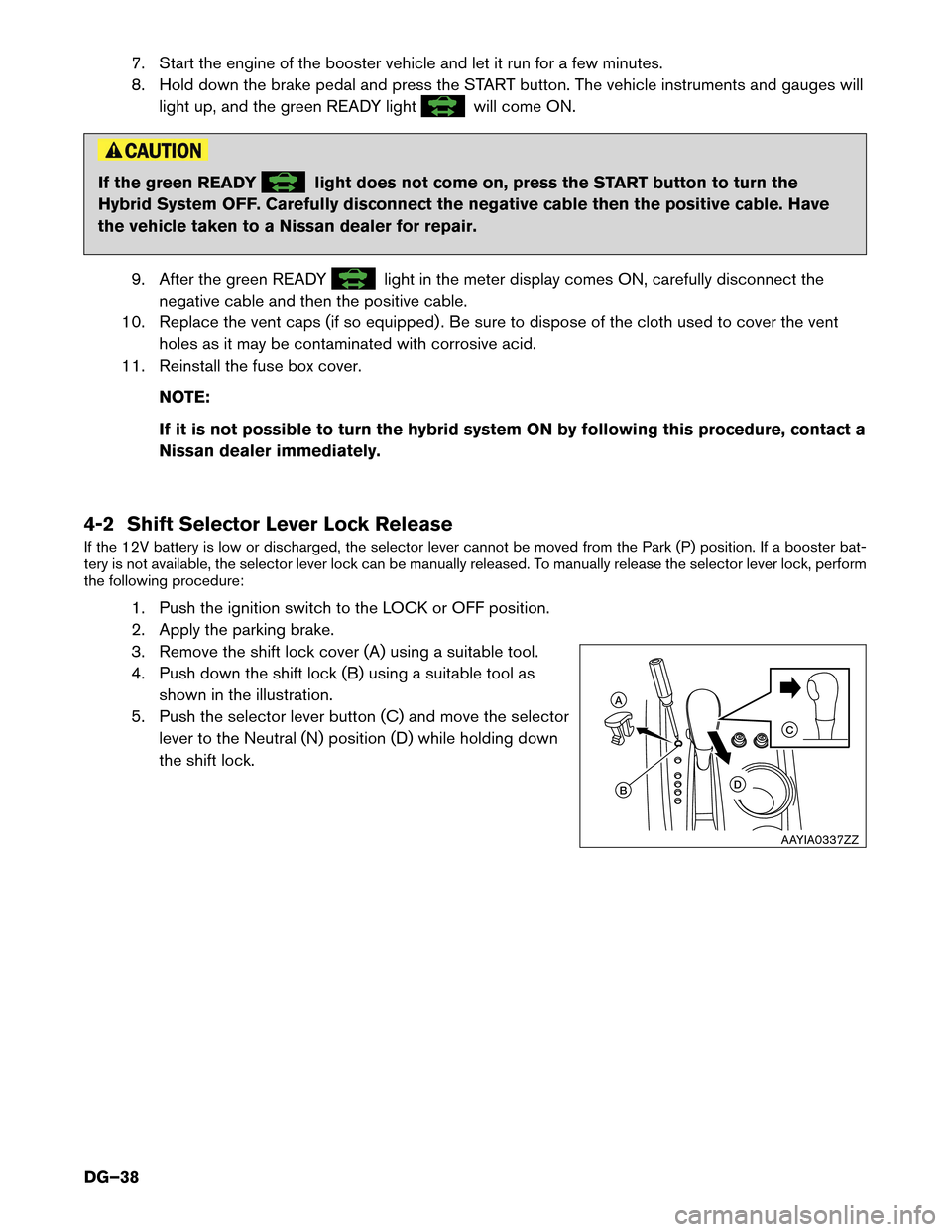Page 20 of 50
9. Release the parking brake.
10. Unbuckle the seat belt and open the driver door. The READY
indicator should remain ON
and the engine should not be running.
11. Turn ON electric devices such as headlamps, A/C (set to the coldest temperature) and rear window defogger to discharge the high voltage battery. Allow approximately 15 minutes to
discharge. Discharge is complete when the READY
indicator (B) (green) turns OFF, the
hybrid system warning indicator (C) (orange) turns ON and the message display indicates “Li-ion
battery low”.
12. Press the ignition switch (A) to turn the system OFF.
Please contact following number if the vehicle could not be discharged. • 1-800-647-7261 (US) or 1-800-387-0122 (Canada)
• Hours of operation are 8am - 5pm (Monday-Friday) Eastern, Central and Pacific time zones.
A
B
C
LOCK
ACC
(OFF)
ON
AAYIA0078GB
1
23
4
5
6
7
8 1
1/2
PWR
PShift to Park
Li-ion battery low
P
Shift to Park
Li-ion battery low
AAYIA0334ZZ
DG–20
Page 35 of 50

3-4.5 Li-ion Battery Damage and Fluid Leaks
The Li-ion battery contains electrolyte solution. To avoid exposure to electrolyte solution
and serious personal injury, always wear appropriate solvent resistant Personal Protective
Equipment (PPE) and read the following precautions:
• Electrolyte solution is a skin irritant.
• Electrolyte solution is an eye irritant – If contact with eyes, rinse with plenty of water andsee a doctor immediately.
• If electrolyte leak occurs, wear appropriate solvent resistant PPE and use a dry cloth to clean up the spilled electrolyte. Be sure to adequately ventilate the area.
• Electrolyte solution is highly flammable
• Electrolyte liquid or fumes that have come into contact with water vapors in the air will create an oxidized substance. This substance may irritate skin and eyes. In these cases,
rinse with plenty of water and see a doctor immediately.
• Electrolyte fumes (when inhaled) can cause respiratory irritation and acute intoxication. Move to fresh air and wash mouth with water. See a doctor immediately.
In cases of battery case breach or electrolyte leakage, contact the fire department immediately. If you must
walk away from the vehicle, notify an appropriate responder of the fact that the vehicle is an electric car and
contains a high voltage system and warn all others.
Li-ion Battery Electrolyte Solution Characteristics: • Clear in color
• Sweet odor
• Similar viscosity to water
• Since the Li-ion battery is made up of many small sealed battery modules, electrolyte solutionleakage should be minimal.
NOTE:
Other fluids in the vehicle (such as engine oil, washer fluid, brake fluid, coolant, etc.) are
the same as those in a conventional vehicle.
DG–35
Page 37 of 50

4-1 Jump Starting Procedures
NOTE:Jumper cable connections under the hood of the Pathfinder HYBRID are not connected
directly to a battery. They are connected to chassis ground and a fuse box terminal. Refer
to the following instructions and the above illustration.
1. Locate the fuse box behind the engine air cleaner.
2. Push the tab in and lift up ○A
to remove the fuse box cover and expose the remote positive battery
terminal ○B
.
3. If the booster battery is in another vehicle, position the two vehicles to bring their batteries near each other.
DO NOT allow the two vehicles to touch.
4. Apply the parking brake. Move the selector lever the P (Park) . Switch off all unnecessary electrical systems (lights, heater, air conditioner, etc.) .
5. Remove vent caps on the battery (if so equipped) of the vehicle with battery for booster. Cover the battery with an old cloth ○F
to reduce explosion hazard.
6. Connect jumper cables in the sequence as illustrated ( ○B
�
○C
�
○D
�
○E
) .
• Always connect positive (+) to positive (+) and negative (-) to body ground (for example,
as illustrated) , not to the 12V battery.
• Make sure the jumper cables do not touch moving parts in the engine compartment and that the cable clamps do not contact any other metal.
F
A
E
D
B
B
+
C
+
Cloth
Vehicle being jump started
Vehicle with battery for booster
AAYIA0072GB
DG–37
Page 38 of 50

7. Start the engine of the booster vehicle and let it run for a few minutes.
8. Hold down the brake pedal and press the START button. The vehicle instruments and gauges willlight up, and the green READY light
will come ON.
If the green READYlight does not come on, press the START button to turn the
Hybrid System OFF. Carefully disconnect the negative cable then the positive cable. Have
the vehicle taken to a Nissan dealer for repair.
9. After the green READY
light in the meter display comes ON, carefully disconnect the
negative cable and then the positive cable.
10. Replace the vent caps (if so equipped) . Be sure to dispose of the cloth used to cover the vent holes as it may be contaminated with corrosive acid.
11. Reinstall the fuse box cover.
NOTE:
If it is not possible to turn the hybrid system ON by following this procedure, contact a
Nissan dealer immediately.
4-2 Shift Selector Lever Lock Release
If the 12V battery is low or discharged, the selector lever cannot be moved from the Park (P) position. If a booster bat-
tery is not available, the selector lever lock can be manually released. To manually release the selector lever lock, perform
the following procedure: 1. Push the ignition switch to the LOCK or OFF position.
2. Apply the parking brake.
3. Remove the shift lock cover (A) using a suitable tool.
4. Push down the shift lock (B) using a suitable tool asshown in the illustration.
5. Push the selector lever button (C) and move the selector lever to the Neutral (N) position (D) while holding down
the shift lock.
B
A
C
D
AAYIA0337ZZ
DG–38